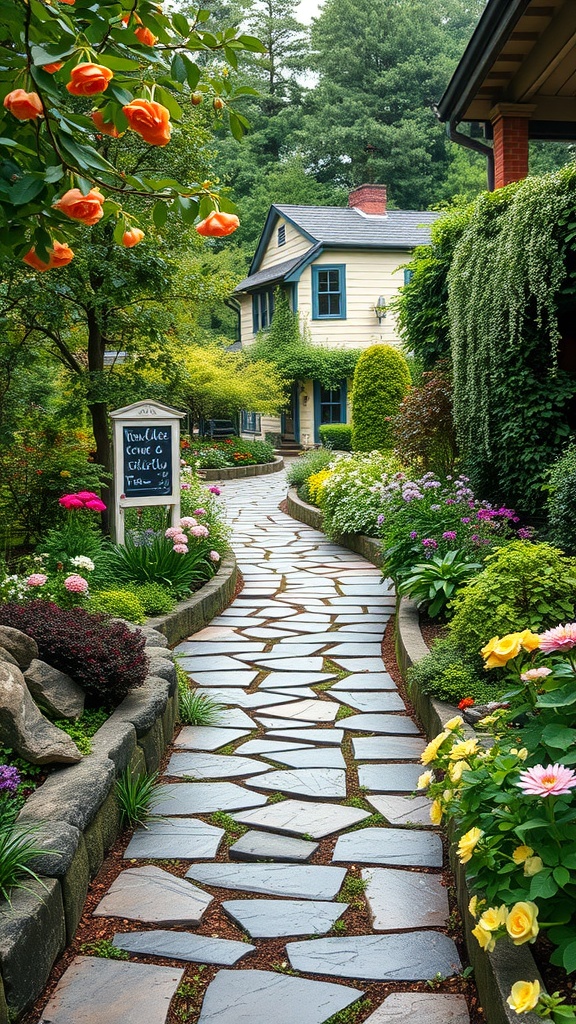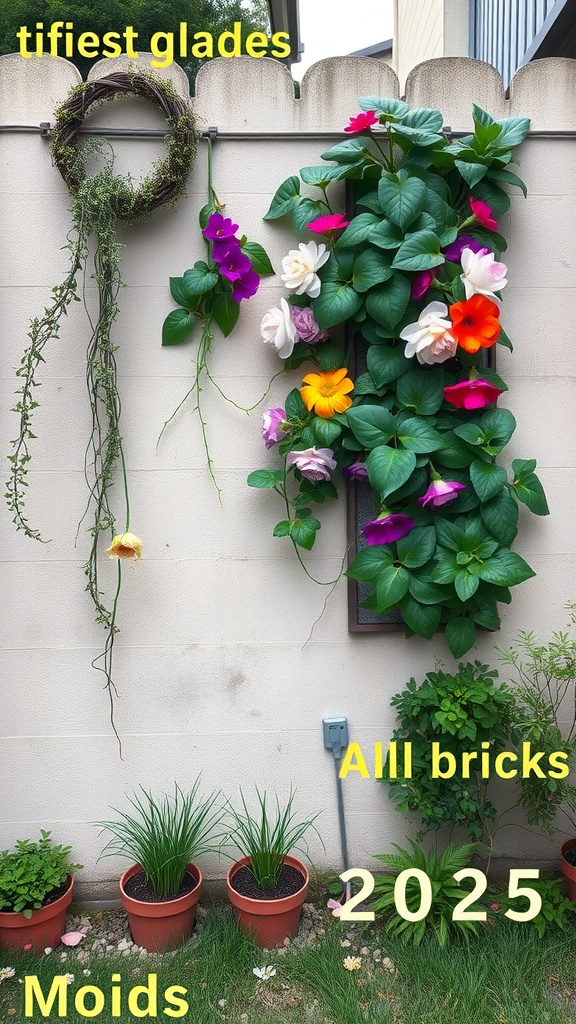Edging Ideas Around Trees dives into creative ways to enhance the beauty and functionality of your outdoor space while keeping your leafy friends in mind. Whether you’re looking to add some charm to your garden or simply want to keep things tidy around the trunks, this guide is packed with practical tips and ideas to help you make the most of your landscaping, all while respecting the natural growth of your trees.
Metal Edging for Modern Landscapes
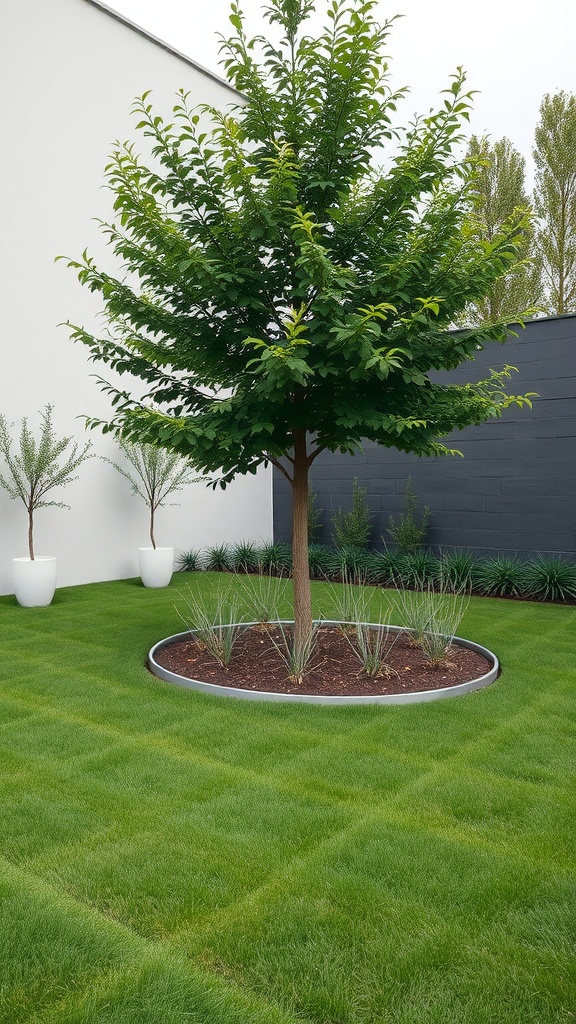
Metal edging is a simple yet stylish way to define garden spaces, especially around trees. In the image, the clean lines of the metal border complement the round bed of mulch and plants, creating a tidy look. This type of edging not only enhances the visual appeal but also helps keep grass and weeds at bay. It’s a practical solution that fits right in with contemporary designs. The sleek appearance of metal against the soft green grass adds a modern touch to the landscape, making the garden feel more organized and polished. Plus, it allows the focus to remain on the beautiful tree and surrounding plants, letting nature shine while maintaining structure. Using metal edging can elevate your outdoor space, providing both form and function while making landscaping maintenance a bit easier.
Natural Stone Borders for Tree Bases
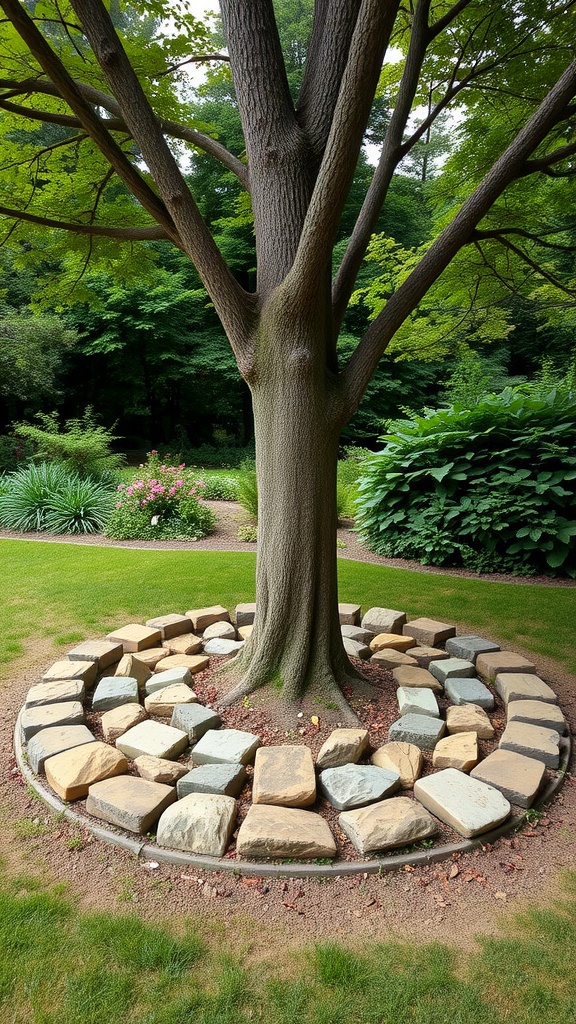
Using natural stone borders around tree bases adds a touch of charm and organization to any landscape. The image shows a beautiful arrangement of stones forming a circular border around a sturdy tree trunk. This design not only enhances the aesthetics but also helps in maintaining the area around the tree.
The stones create a defined edge that can prevent grass and weeds from encroaching on the tree’s space. This is particularly useful for protecting the root zone. Additionally, it makes mowing and trimming the grass easier, giving a tidy look to your garden.
When selecting stones, consider using a mix of colors and sizes. This adds visual interest and can complement the surrounding plants. Natural stones blend well with the earth tones of garden spaces, making them a popular choice for many gardeners.
Moreover, the circular pattern around the tree can symbolize unity and growth, reflecting the life that the tree provides. It invites visitors to appreciate the beauty of nature while keeping the area neat and functional.
Brick Edging with a Classic Touch
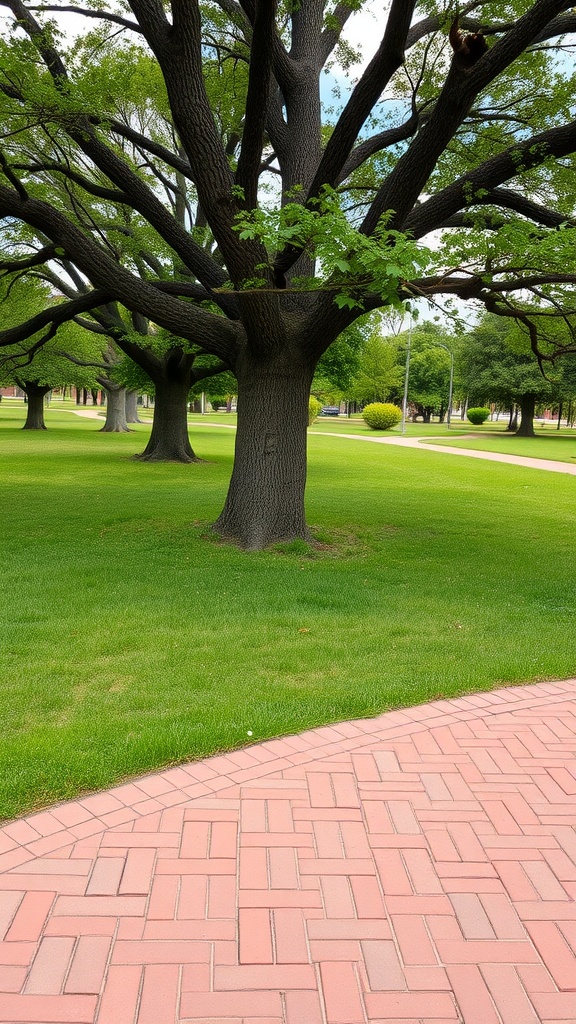
In this image, we see a beautifully landscaped area featuring a majestic tree surrounded by a well-defined brick edge. The contrast between the vibrant green grass and the warm tones of the brick creates a lovely, inviting space.
Brick edging is an excellent idea for demarcating areas in your garden, especially around trees. It not only adds a classic touch to your landscape but also helps contain mulch and soil, preventing erosion. This practical approach enhances the overall aesthetic while keeping things tidy.
When laying down brick edging, consider following the natural curves of the landscape. This design technique allows the bricks to complement the tree’s organic shape, making the space feel more cohesive. Plus, the texture of the bricks contrasts nicely with the smooth bark of the tree, adding depth to the scene.
Colorful Pavers for Vibrant Landscaping
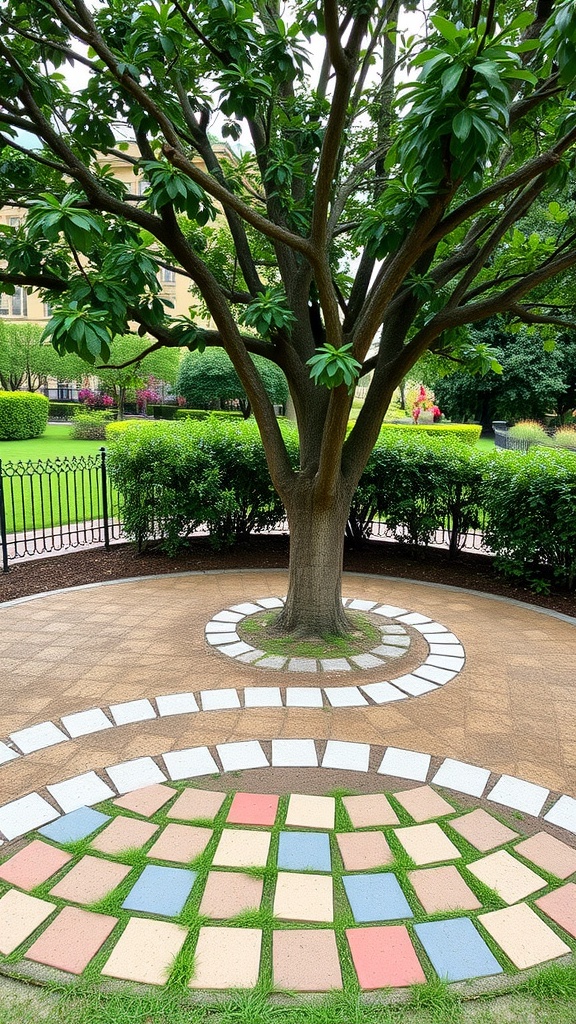
Adding colorful pavers around trees can really enhance your landscape. In the image, we see a lovely arrangement of pavers in various colors, creating a cheerful vibe. The soft curves and shapes around the base of the tree invite us to engage with the space.
These pavers not only look good but also serve practical purposes. They help define the area around the tree, making it easier to maintain. Additionally, the design allows for water drainage, which is crucial for the tree’s health.
When choosing pavers, think about how the colors will complement your garden. The mix of pastel shades in the image adds a touch of playfulness. Consider using colors that match your plants or the overall theme of your yard to create a cohesive look.
Lastly, don’t forget to incorporate greenery! The patches of grass between the pavers bring life to the design. Keep the area tidy to ensure that your colorful pavers and the tree continue to shine together.
Recycled Materials for Eco-Friendly Edging
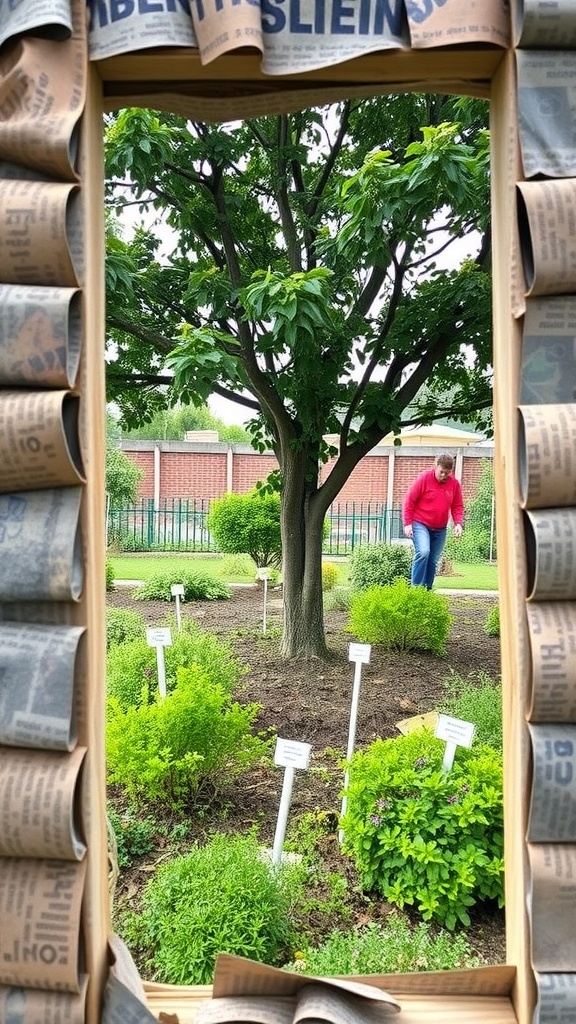
Using recycled materials for garden edging is not just practical; it adds character to your space. In the image, we see a vibrant garden framed by what looks like rolled-up newspaper. This creative idea showcases how everyday items can transform your landscaping.
Recycled materials can range from old bricks to wooden pallets. The newspaper edging in the picture not only defines the garden beds but also emphasizes a commitment to sustainability. It’s a simple, low-cost solution that makes a statement.
As we look at the lush greenery around the tree, it’s clear that recycled edging complements the natural environment. It blends seamlessly while providing functionality, such as keeping soil in place and preventing grass from invading flower beds.
Using recycled materials is a win-win for both your garden and the planet. It encourages creativity, allowing you to express your style while reducing waste. So, grab those old items you have lying around, and see how you can use them to edge your garden beautifully!
Cement Borders for Low Maintenance
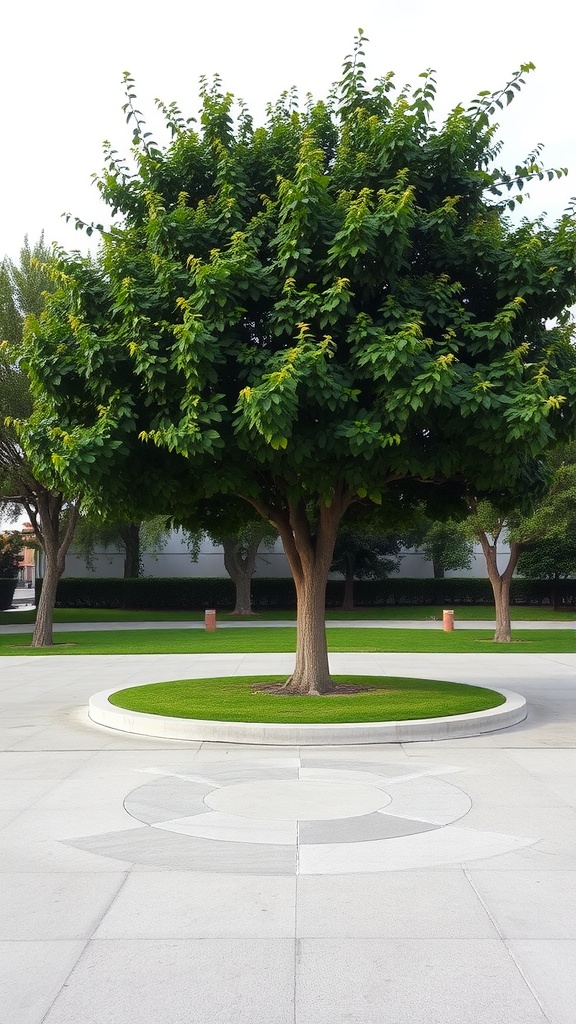
Cement borders work wonders when it comes to maintaining a neat look around trees. In the image, you can see a tree standing proudly in the center of a well-defined circular cement border. This design not only enhances the visual appeal but also helps keep grass and weeds at bay.
Using cement creates a durable boundary that requires little upkeep. With no need to constantly trim or edge the grass, you can spend more time enjoying your garden. The smooth finish of the cement also makes it easy to clean and resistant to wear and tear.
Furthermore, cement borders can be crafted in various shapes and sizes. This flexibility allows you to tailor the design to fit perfectly around your trees. The rounded border in the image gives a soft, inviting feel to the landscape, complementing the lush green leaves of the tree.
Incorporating cement borders means less hassle and more time to relax outdoors. It’s a practical solution that adds style while keeping your garden tidy. Whether you have one tree or multiple, these borders ensure that your landscape remains low maintenance and visually appealing.
Wooden Edging for Rustic Appeal
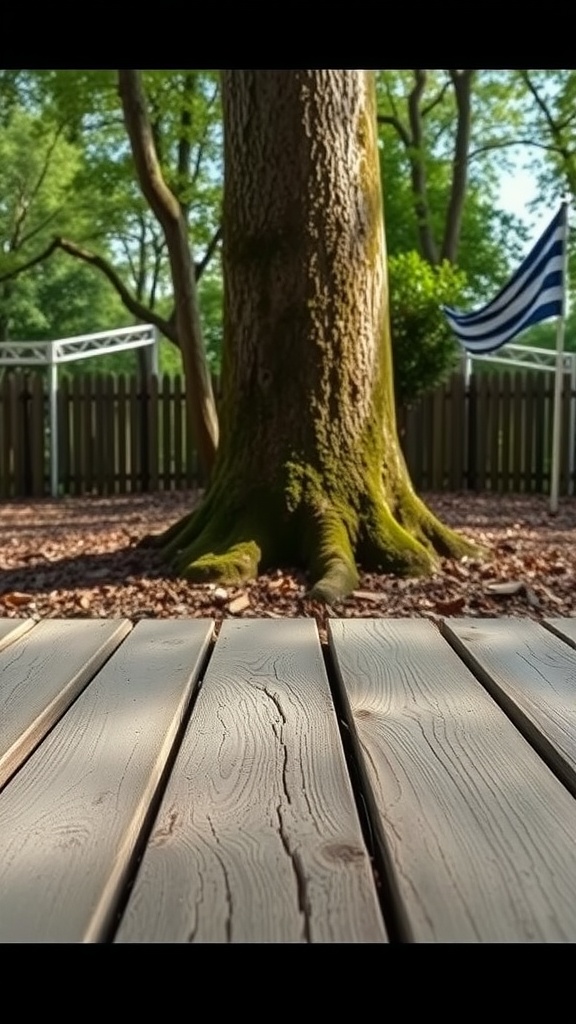
When we think about enhancing our outdoor spaces, using wood for edging can bring a warm, rustic charm. In the image above, we see a large tree standing proudly, surrounded by natural elements that make the spot feel inviting. The wooden deck in the foreground adds a touch of elegance while maintaining a casual vibe.
Wooden edging around trees not only helps define the space but also keeps mulch and soil in place, creating a neat look. It offers a natural transition from garden beds to pathways, blending seamlessly with the landscape. The rich textures of wood complement the rough bark of the tree, adding depth to the scene.
Another benefit of wooden edging is its versatility. You can choose different types of wood, stains, and finishes to match your style. Whether you prefer a weathered look or something more polished, there’s an option for everyone. In this setting, the wooden edging feels right at home, enhancing the overall rustic appeal.
So, if you’re considering ways to spruce up your garden, think about incorporating wooden edging. It can enhance the natural beauty of your outdoor space while keeping it tidy. Plus, it’s a simple way to create areas for planting or relaxing, just like the inviting scene we see in the image.
Grit and Gravel for a Natural Look
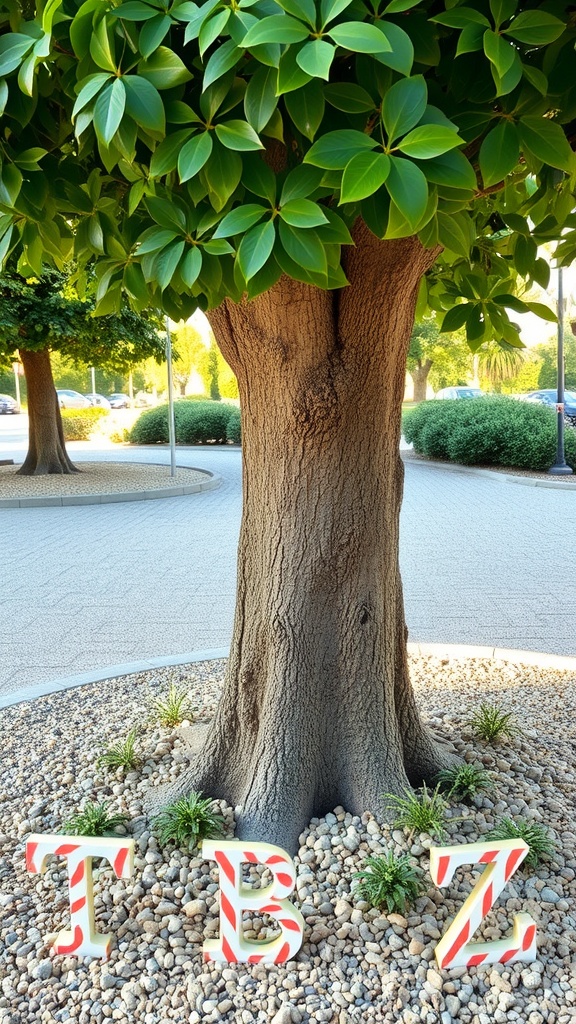
When it comes to landscaping around trees, grit and gravel offer a charming, natural aesthetic that blends beautifully with the organic forms of nature. The image shows a majestic tree surrounded by a bed of pebbles, which creates a serene atmosphere. This setup not only looks appealing but also serves practical purposes.
Using gravel around trees helps with drainage, ensuring that water does not pool around the trunk. This is essential for the tree’s health, as it prevents root rot. The pebbles also suppress weeds, which can compete with the tree for nutrients and water.
The decorative letters in the foreground add a playful touch to the scene. Their bright colors contrast nicely with the earthy tones of the gravel and the rich green leaves above. This mix of elements can inspire you to add your unique flair to similar landscaping projects.
Incorporating low-maintenance plants, like those seen in the image, can also enhance the look. They add texture and interest without demanding too much care. So, if you’re thinking about edging ideas around your own trees, consider the benefits of grit and gravel for that relaxed, natural vibe.
Mulch for Moisture Retention
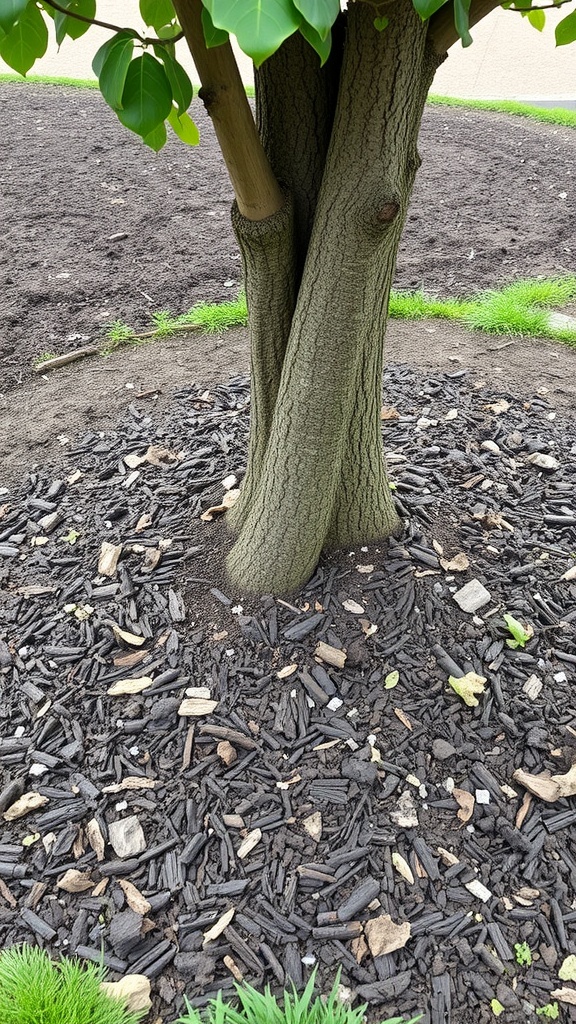
In the image, you can see a tree surrounded by a thick layer of mulch. This setup is a practical choice for preserving moisture in the soil. The dark, textured mulch creates a barrier that helps keep water where it’s needed most—around the tree’s roots.
Mulch acts like a sponge, soaking up rainwater and reducing evaporation. This is especially important during hot summer months when trees can struggle to get enough hydration. The mulch also regulates soil temperature, keeping it cooler in the heat and warmer during colder periods.
Additionally, using mulch can prevent weed growth. Weeds compete with your tree for nutrients and water. With a good layer of mulch, you can minimize this competition, giving your tree a better chance to thrive.
When applying mulch, aim for a layer about two to four inches thick, making sure to keep it away from the tree trunk to avoid rot. You’ll not only help your tree but create a tidy, appealing look in your garden.
Planting Flowers for Added Color
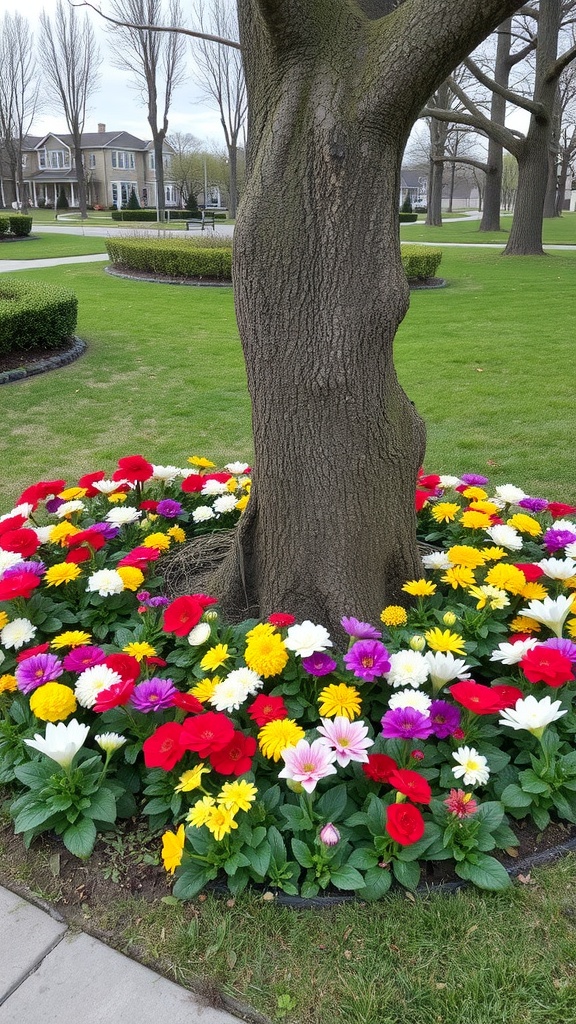
When it comes to adding charm to your garden, planting flowers around trees is a delightful idea. The image shows a vibrant display of flowers encircling a sturdy tree trunk, creating a warm and inviting atmosphere. The mix of colors—from cheerful yellows to deep reds—adds life to the landscape.
Choosing the right flowers is key. Consider planting seasonal blooms that thrive in your climate. Marigolds, begonias, and daisies are great options, as they bring cheerful colors and are relatively easy to care for. You can also plant perennials for long-lasting beauty.
Make sure to prepare the soil well. Dig a circle around the base of the tree, ensuring you don’t harm its roots. This will help your flowers establish themselves better. Keep them watered, especially during dry spells, to keep your floral arrangement looking fresh.
Incorporating flowers not only enhances the beauty of your garden but also supports local wildlife. Bees and butterflies are attracted to these blooms, contributing to a healthy ecosystem. So, grab your gardening gloves, and let’s bring some color to those tree bases!
Terracing Around Tree Roots
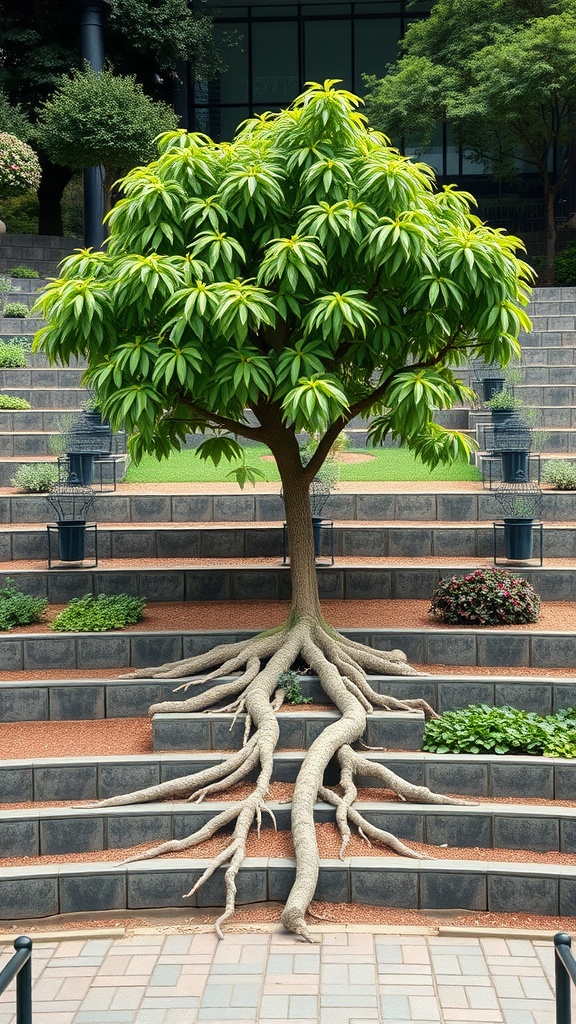
Creating terraces around tree roots can enhance both the aesthetic and practical aspects of your garden. In the image, you see a beautifully manicured tree with impressive roots that stretch across multiple levels. This design highlights how terracing can be both functional and visually appealing.
When planning your own terracing, it’s essential to consider the tree’s root system. The roots provide stability and nutrients to the tree, so building around them requires care. Using materials like stone or brick can help create defined terraces that showcase the roots without damaging them.
Incorporating plants in the terraces can also soften the look. Lush greenery and colorful flowers around the tree can add depth and vibrancy to the garden space. Make sure to choose plants that thrive in the same conditions as the tree to create a harmonious environment.
Lastly, terracing can prevent soil erosion, especially in sloped areas. By creating tiered levels, you help retain moisture and reduce runoff, benefiting both the tree and surrounding plants. This method not only elevates the garden’s appearance but also supports its health.
Creative Use of Logs for Edging
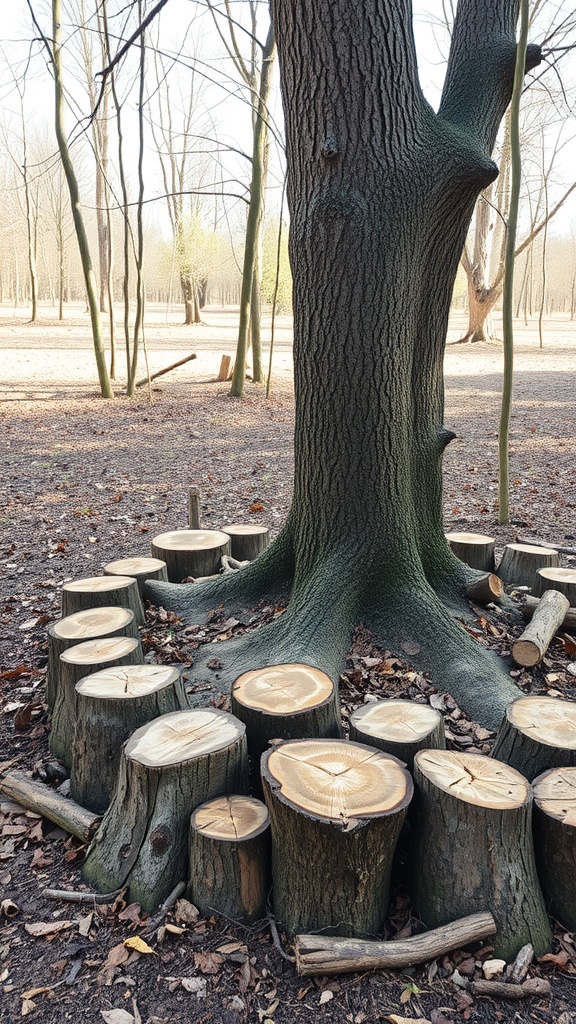
Using logs for edging around trees is a simple yet effective way to enhance your outdoor space. In the image, you can see a tree surrounded by a circle of cut logs, creating a natural border that adds charm to the area.
This method not only looks appealing but also helps define the space around the tree. The round shape of the logs contrasts nicely with the trunk and complements the natural setting. It’s a friendly reminder of how nature can be part of our gardening efforts.
Logs can be sourced from fallen trees or even from your own yard, making this an eco-friendly option. It’s a great way to recycle wood and keep it out of the landfill. Plus, the rustic look fits perfectly in a garden or woodland inspired landscape.
To create your own log edging, start by measuring the area around your tree. Then, gather logs of similar height and arrange them to form a circle. You can dig a shallow trench to help secure the logs in place. This simple task can give your garden a neat, organized feel while keeping the natural vibe intact.
Edging with Landscaping Fabric
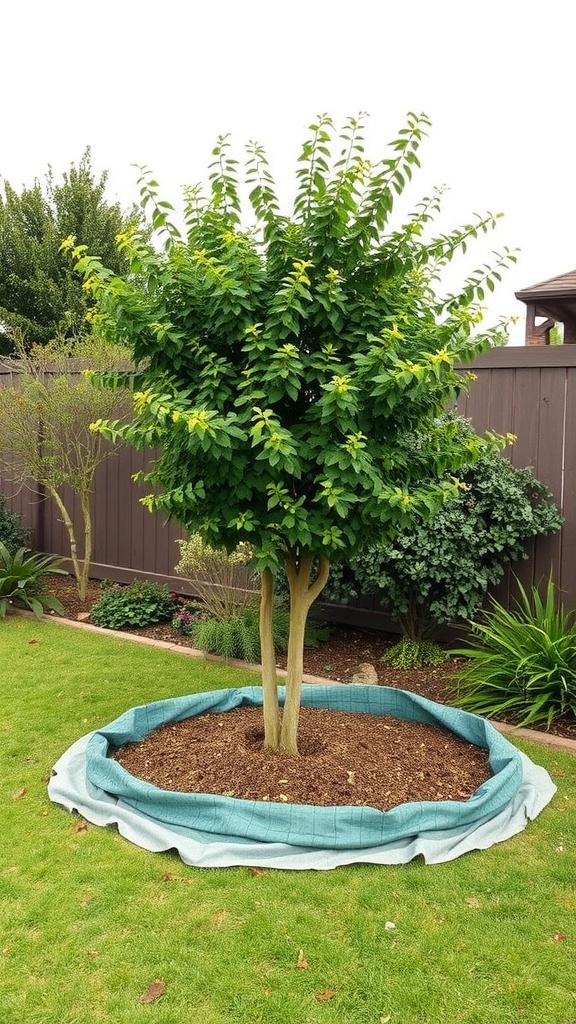
Using landscaping fabric around trees is a smart choice for both functionality and aesthetics. In the image, we see a well-cared-for tree, surrounded by a circular area of landscaping fabric. This setup helps define the space around the tree while keeping it neat and tidy.
The fabric serves multiple purposes. First, it blocks weeds from growing, which means less maintenance for you. Weeds can compete with your tree for nutrients and water, so keeping them at bay is essential. Second, the fabric allows water and nutrients to penetrate, helping your tree thrive.
Another benefit is the visual appeal. The fabric creates a clear boundary that highlights the tree and its surrounding area. This makes your garden look organized and polished. Plus, you can add mulch on top of the fabric for an extra layer of protection and to enhance the look.
When installing landscaping fabric, make sure to cut it to the desired shape and size. Lay it down smoothly to avoid wrinkles or folds. Then, secure it with landscape staples. Once in place, you can add mulch or stones to complete the look.
Remember, the goal is to create a space that not only protects your tree but also elevates the overall design of your garden. With a little effort, your trees will stand out beautifully!
Seasonal Decorations for Tree Edging
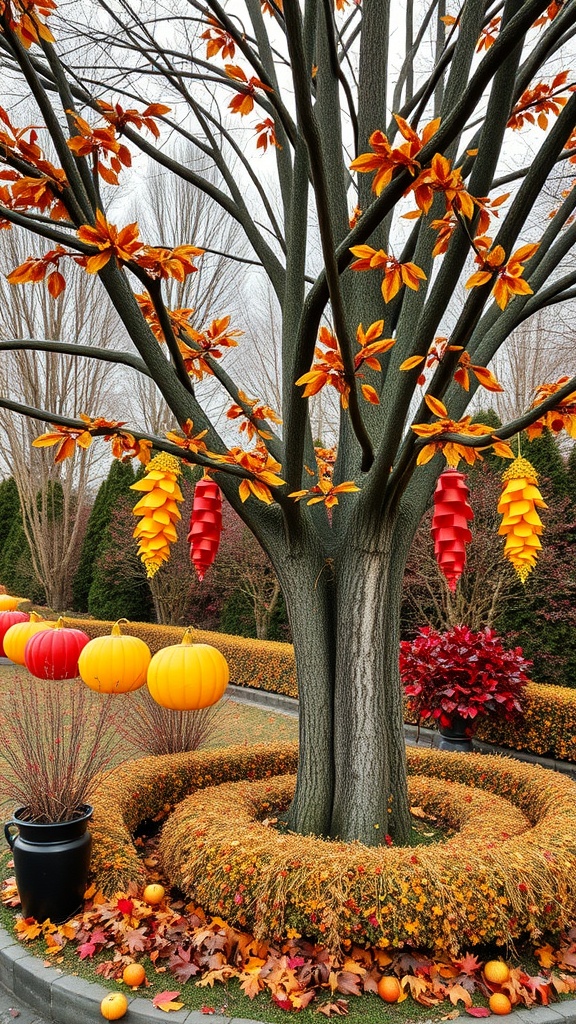
When it comes to enhancing the beauty of trees in your garden, seasonal decorations can really bring them to life. The image showcases a creatively designed tree surrounded by vibrant colors and textures that capture the essence of fall.
The tree features bright orange and yellow leaves, which mimic the natural changes in foliage during this season. Hanging decorations like the red and yellow cones add a playful touch, making the tree a focal point in the landscape.
Furthermore, the circular edging created with flowers and autumn leaves gives a warm and inviting feel to the space. This design not only highlights the tree but also creates a cozy atmosphere that’s perfect for gatherings. Potted plants with colorful foliage surrounding the tree add more depth to the scene.
Incorporating pumpkins in various colors enhances the seasonal charm. Whether real or artificial, they bring a classic fall vibe that’s hard to resist. You can easily replicate this look by gathering colorful elements from your local market and arranging them around your trees.
So, as the seasons change, think about how you can dress up your trees with simple yet effective decorations. It’s a fun way to celebrate nature and add character to your outdoor space!
Rope or Twine Borders for a Beachy Feel
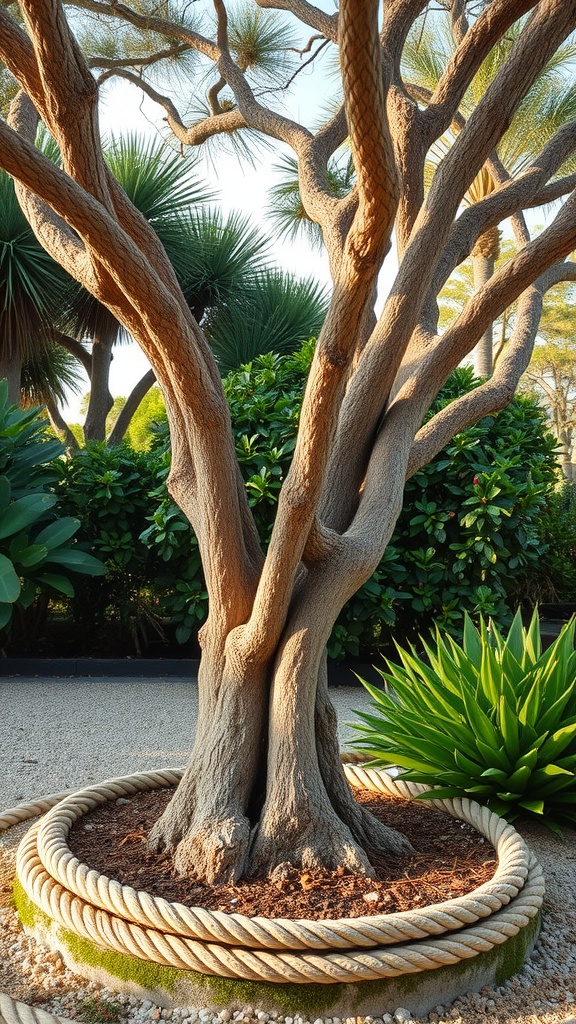
Creating a beachy vibe in your garden can be as simple as adding some twine or rope borders around your trees. In the image, you see a beautiful tree encircled by a thick rope, giving it a relaxed coastal charm.
This design not only defines the space around the tree but also introduces a rustic element. The natural texture of the rope contrasts nicely with the smooth bark of the tree, making it a focal point in any outdoor setting.
Using rope or twine can also help keep mulch in place, promoting moisture retention in the soil. This practical touch ties in nicely with the carefree aesthetic of beach living.
When considering this option, think about how it complements your existing garden elements. The greenery surrounding the tree enhances the overall beach-inspired look, making your outdoor area feel inviting and cozy.
Using Boulders for a Natural Barrier
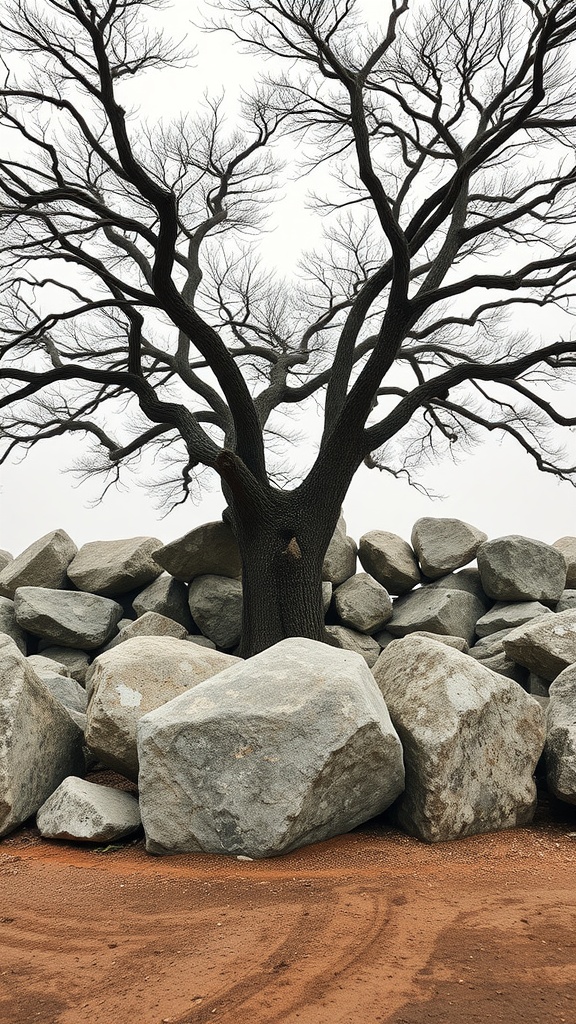
In landscaping, creating boundaries can enhance the beauty of your garden. The image highlights a powerful natural barrier made from boulders surrounding a tall, leafless tree. This setup not only defines a space but also adds visual interest.
Boulders can act as both a functional and decorative element. They create a solid, natural boundary that keeps soil in place and prevents erosion. Plus, they blend seamlessly with the environment, offering a rustic charm. As shown, the boulders frame the tree, emphasizing its stature and creating a striking focal point.
When placing boulders, consider their size and shape. Larger stones can create a more dramatic effect, while smaller ones can be used for subtlety. It’s all about balance. The rocky texture contrasts beautifully with the smooth bark of the tree, enriching the overall design.
This approach also supports wildlife. The gaps between the boulders can provide shelter for small animals and insects. Thus, not only do you beautify your space, but you also contribute to the ecosystem.
Fencing Options for Tree Protection
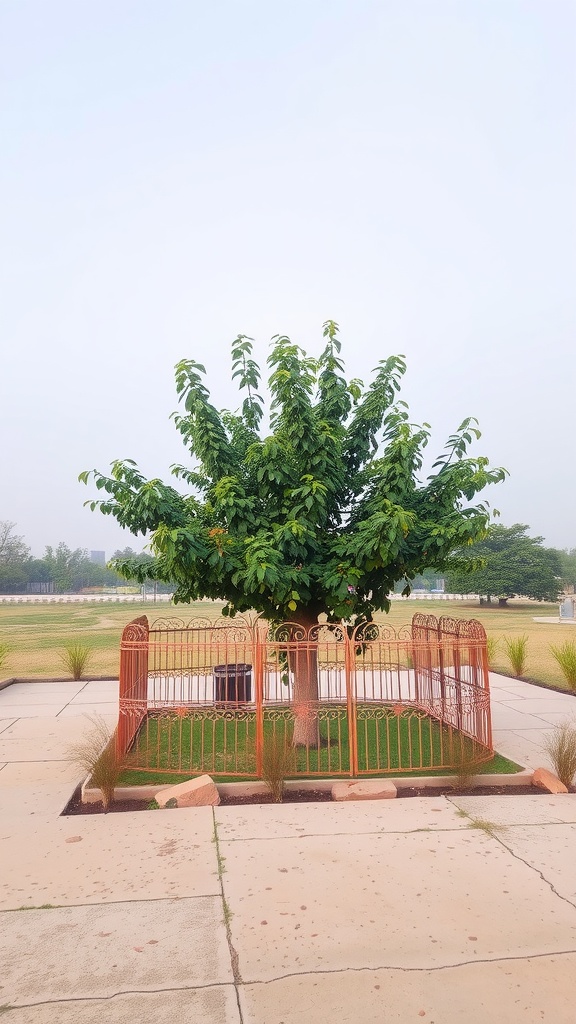
When it comes to keeping our trees healthy, choosing the right fencing can make all the difference. The image portrays a lovely tree surrounded by a decorative fence, illustrating a practical approach to tree protection. This setup not only safeguards the tree but also adds an aesthetic touch to the landscape.
A fence like the one shown can serve multiple purposes. It keeps away curious pets and children who might inadvertently harm the tree. Plus, it helps to maintain a tidy area around the trunk, reducing competition from weeds and grass for nutrients and water. By opting for a stylish fence, you can enhance the overall look of your garden while ensuring that your tree flourishes.
There are various fencing materials you can consider. Metal fencing offers durability, while wooden options can blend beautifully with natural surroundings. If you’re looking for something more eco-friendly, you might explore living fences, which include shrubs or small trees planted close to the main tree. Each choice has its benefits, so think about what best suits your space and style.
Overall, protecting your tree with a fence can promote its health and longevity. Whether you prefer a simple barrier or a decorative feature, the right fencing option can elevate your landscape and keep your tree safe.
Living Edges with Ground Cover Plants
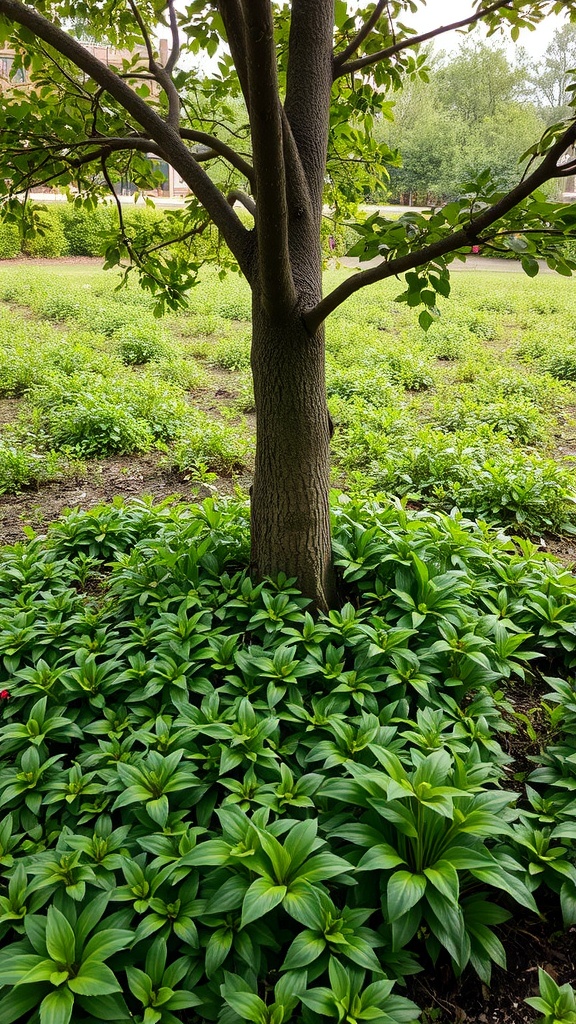
Ground cover plants create a lush, green carpet around trees, enhancing the beauty of any garden. In the image, we see a tree surrounded by vibrant, leafy plants that thrive in the shade. These plants not only look appealing but also help in maintaining soil moisture.
Choosing the right ground cover for your trees can be rewarding. They suppress weeds, reduce erosion, and can even attract beneficial insects. Look for varieties that are tolerant to shade and complement the tree’s root structure.
In this scene, the ground cover plants seem healthy and well-established, creating a lovely space beneath the tree. This setup encourages a harmonious relationship between the tree and the plants, making the area inviting and serene.
Integrating Pathways with Tree Edging
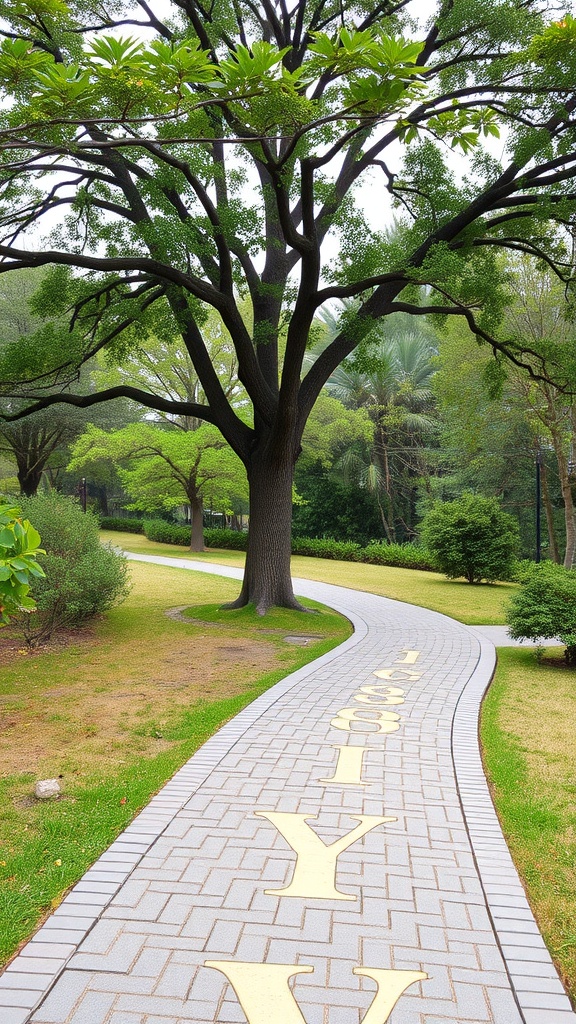
Creating a harmonious blend of pathways and tree edging can transform your outdoor space into a serene retreat. The image showcases a gently winding pathway, bordered by lush greenery and a majestic tree. This design invites you to take a stroll and enjoy nature’s beauty.
The pathway’s layout is not only functional but also aesthetically pleasing. Its gentle curves mimic the natural shapes found in nature, making it feel less rigid and more inviting. This design principle encourages exploration and relaxation.
Incorporating trees along the edges of pathways provides shade and a sense of enclosure, making the space feel cozy. The vibrant green leaves create a refreshing atmosphere, perfect for leisurely walks or quiet moments. As you walk along the path, the tree’s presence becomes a focal point, enhancing the overall landscape.
Consider using materials that complement the natural environment when designing your pathway. The textured pavers in the image add character and contrast beautifully with the surrounding grass. This attention to detail can elevate the space and make it feel more intentional.
Incorporating Lighting into Tree Edging
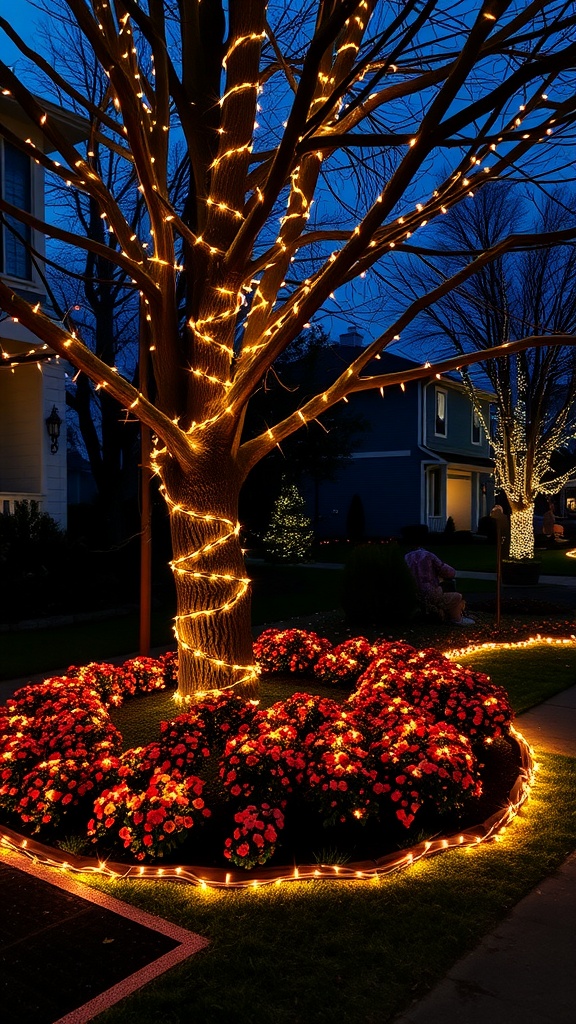
When it comes to enhancing the beauty of your garden, lighting can play a key role, especially around trees. The image showcases a tree elegantly wrapped in warm, twinkling lights, creating a cozy atmosphere. These lights not only highlight the tree’s shape but also draw attention to the vibrant flowers below.
Consider the placement of your lights. Wrapping them around the trunk and branches of the tree adds depth and dimension. The gentle glow creates a focal point that’s inviting, especially during nighttime. It’s a simple yet effective way to elevate your outdoor space.
In addition to the tree, the arrangement of flowers provides a pop of color that complements the lighting. Surrounding the tree with bright flowers enhances the visual appeal. Choosing flowers that bloom in various seasons ensures that your garden remains lively year-round.
Don’t forget about the path! Incorporating lights along the edges can guide guests through your garden. This not only improves safety but also adds a magical touch. Whether it’s string lights or solar-powered stakes, lighting can transform your outdoor experience.
Cacti and Succulents for Desert Landscapes
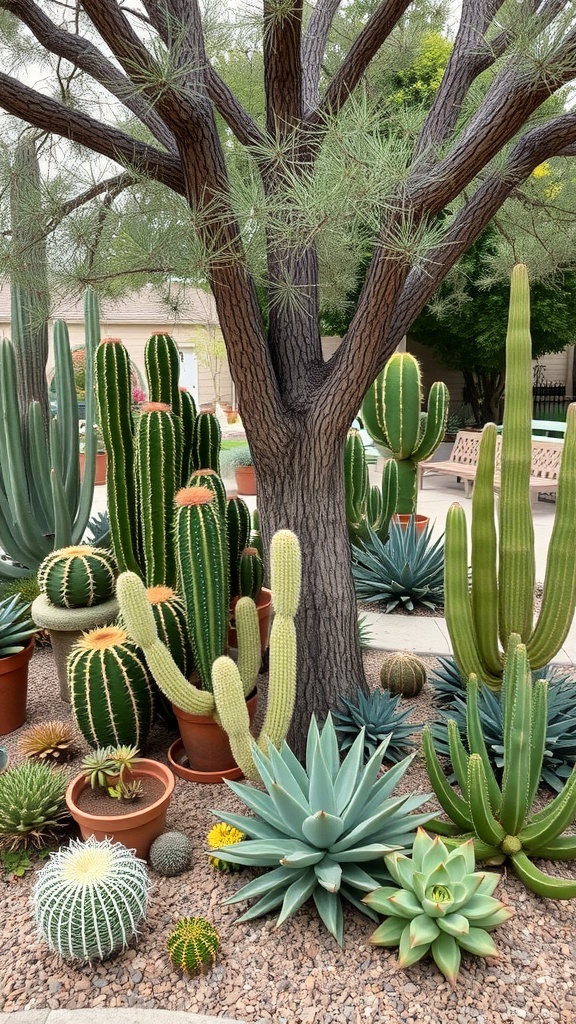
In this desert landscape, the combination of cacti and succulents adds a unique touch around the trees. The tall, spiky cacti stand proudly next to the lush succulents, creating a vibrant display of green and texture.
The tree in the center provides necessary shade, which is essential for many of these plants. Cacti and succulents thrive in the hot sun, but they also appreciate a little protection from the harshest rays. This balance creates a harmonious garden environment.
Potted plants, like the ones seen here, are a great way to introduce different varieties without committing to permanent garden beds. You can easily rearrange them to suit your style or seasonal preferences. Just make sure to choose pots that allow for proper drainage!
Choosing the right type of cacti and succulents will ensure that they flourish. Look for varieties that are known for their adaptability to your specific climate. This way, you’ll see them thrive year after year.
Using Gravel for a Zen Garden
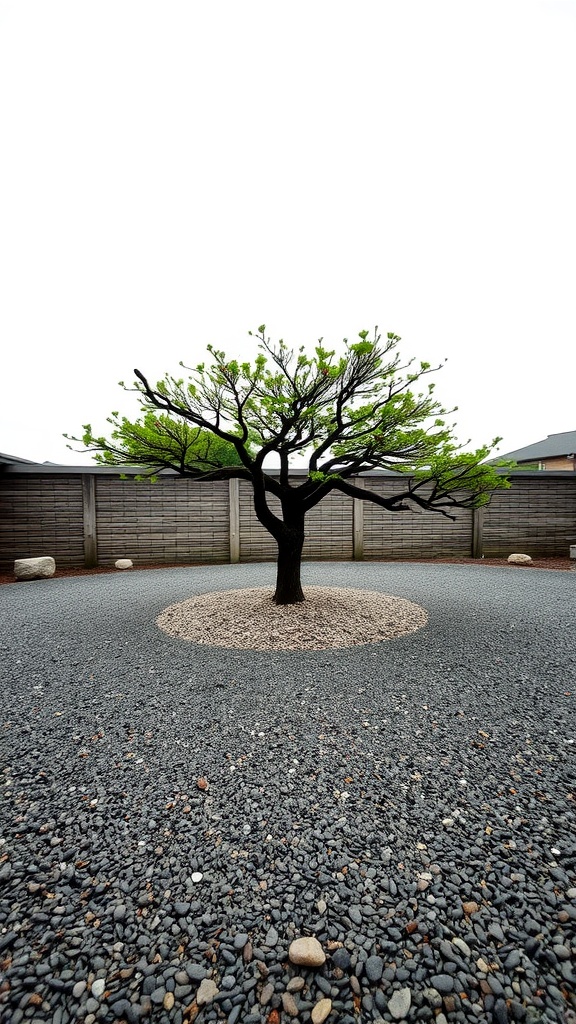
A Zen garden often evokes feelings of peace and tranquility, and the image beautifully captures this essence. In the center, a lone tree stands proudly amidst a sea of gravel, symbolizing strength and resilience. The surrounding gravel is carefully arranged, creating a calming effect that draws the eye.
The choice of gravel as a base material is both practical and aesthetic. Gravel provides excellent drainage while allowing for easy maintenance. Its neutral color complements the vibrant greenery of the tree, enhancing the overall design. By using varying sizes of gravel, you can create patterns that mimic flowing water, adding to the serene vibe.
In a Zen garden, every element plays a role. The space invites mindfulness and reflection, making it an ideal spot for meditation or simply enjoying nature. Adding a few smooth stones around the base of the tree can create balance and harmony, completing the look.
To cultivate your own Zen garden, start with a simple layout. Select a central feature, like a tree or a larger stone, then surround it with gravel. Use a rake to create gentle waves in the gravel, which can symbolize water ripples. This simple approach can turn any outdoor space into a peaceful retreat.
Textured Concrete for Unique Edging
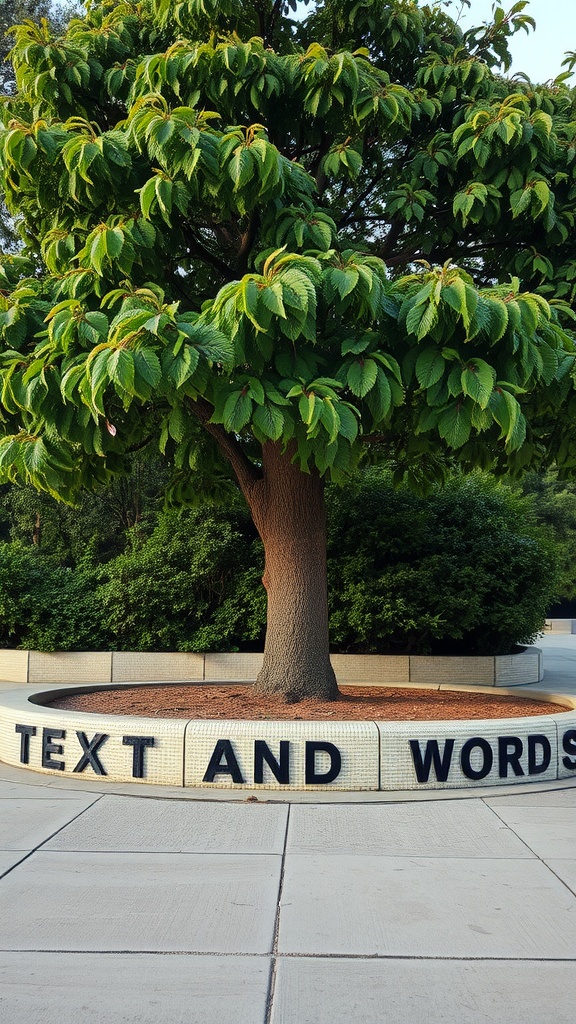
Imagine walking through a park and being greeted by a tree that stands tall, surrounded by an eye-catching concrete border. This textured concrete not only serves a practical purpose but also adds a unique flair to the setting. The mix of nature and design creates an inviting atmosphere.
The image showcases a vibrant tree enveloped in lush green leaves, with the words ‘TEXT AND WORDS’ prominently displayed in bold lettering around its base. This clever use of concrete edging helps define the space while providing a canvas for artistic expression. It’s a simple way to blend functionality with creativity.
Using textured concrete as edging is more than just aesthetics. It can guide foot traffic, prevent soil erosion, and keep mulch in place. Additionally, the texture offers a tactile contrast against the smoothness of the tree’s bark, enhancing the overall visual interest.
Whether you’re looking to create a serene garden or a lively park, consider incorporating textured concrete edging. It’s a thoughtful approach that can make any outdoor space feel more cohesive and welcoming.
Dynamic Patterns with Edging Stones
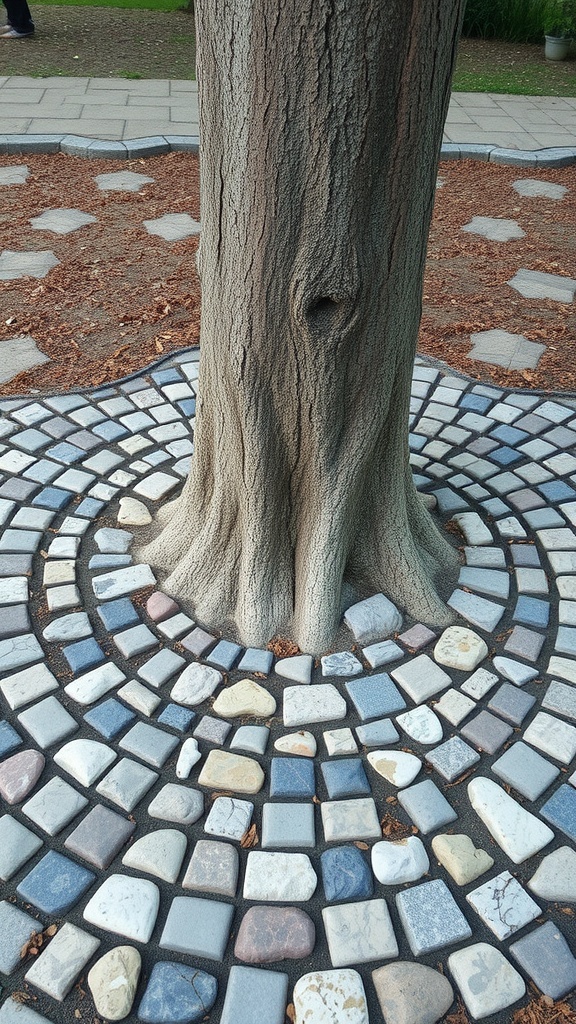
Edging stones can beautifully enhance the area around trees, creating stylish patterns that draw the eye. The image showcases a tree with a circular stone pattern surrounding its base. This arrangement not only highlights the tree’s structure but also adds texture and depth to the landscape.
The variation in stone shapes and colors contributes to a natural feel while framing the tree. It’s a practical solution that helps define space and prevents grass or weeds from encroaching on the tree’s roots. This method encourages a tidy and well-maintained appearance in any garden or park.
Creating dynamic patterns with edging stones is a fun way to express creativity. You can mix different sizes and colors to design a unique look. Whether you choose a simple circular pattern or something more intricate, the key is to complement the natural beauty of the tree while making it a focal point in your outdoor space.
Natural Pathway Integration with Tree Edges
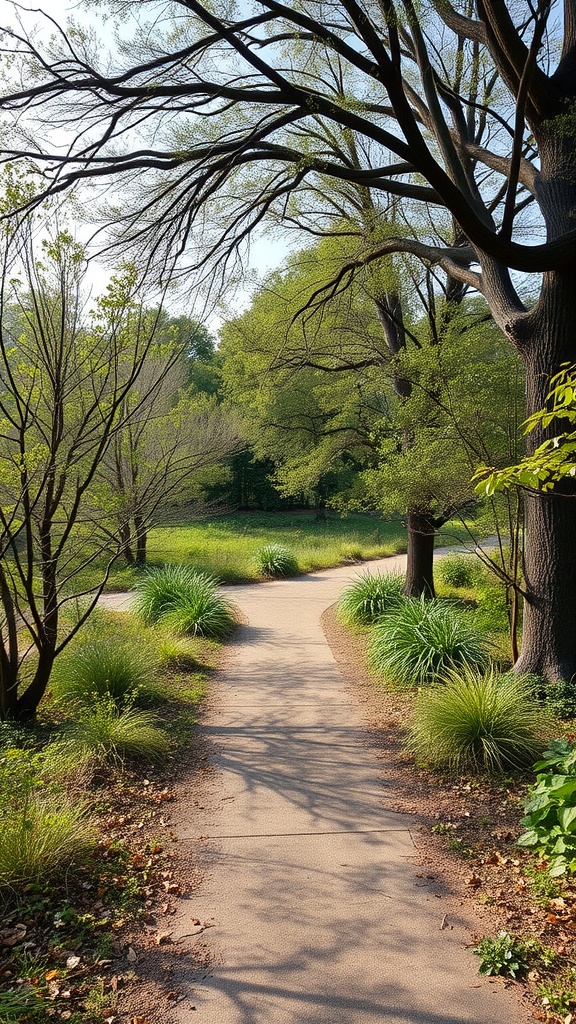
Imagine strolling along a winding pathway embraced by lush greenery and towering trees. The image captures this serene experience beautifully, showcasing how nature and pathways can dance together. The trees stand tall, their branches reaching out as if inviting you to come closer.
The gentle curves of the path create a sense of flow, guiding your steps while maintaining a natural feel. This design integrates the trees seamlessly, allowing for an organic interaction between the man-made and the natural world. As you walk, you can appreciate the textures of the tree bark and the colors of the leaves, enhancing the sensory experience.
The surrounding grass adds a soft touch, complementing the sturdy roots of the trees. This combination not only makes the pathway more visually appealing but also encourages wildlife to thrive. Birds might flutter nearby, and small animals could make their homes in the underbrush, adding life to your stroll.
Creating such natural pathways is all about respecting the existing landscape. Designers can take cues from the trees’ positions and shapes, ensuring that the path feels like it belongs. This approach fosters a sense of harmony, making the journey enjoyable and peaceful.
Edging with Drought-Resistant Plants
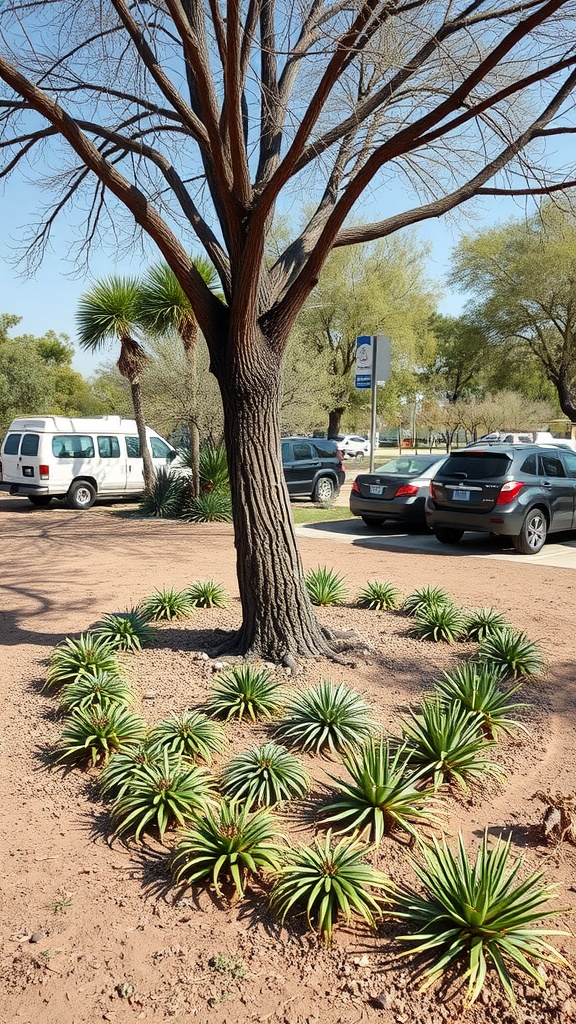
In this image, we see a lovely arrangement of drought-resistant plants surrounding a strong, sturdy tree. The plants form a circular pattern, creating a natural edge that enhances the overall look of the garden. This design not only adds visual interest but also showcases the practicality of choosing the right plants for your landscape.
Drought-resistant plants are a smart choice for edging around trees, especially in areas where water conservation is essential. These hardy plants can thrive in dry conditions while providing a lush appearance. They require less upkeep and help reduce water usage, making them an eco-friendly option.
The combination of the tree and the drought-resistant plants creates a beautiful contrast. The tree stands tall and provides shade, while the surrounding plants add texture and color. This approach can be a lovely way to draw attention to the tree itself, creating a focal point in your garden.
When selecting drought-resistant plants for edging, consider varieties that complement the tree and the existing landscape. Succulents, ornamental grasses, and certain types of agave are excellent options. They not only survive in tough conditions but also bring unique shapes and colors that make any garden more inviting.
Innovative Use of Recycled Tires
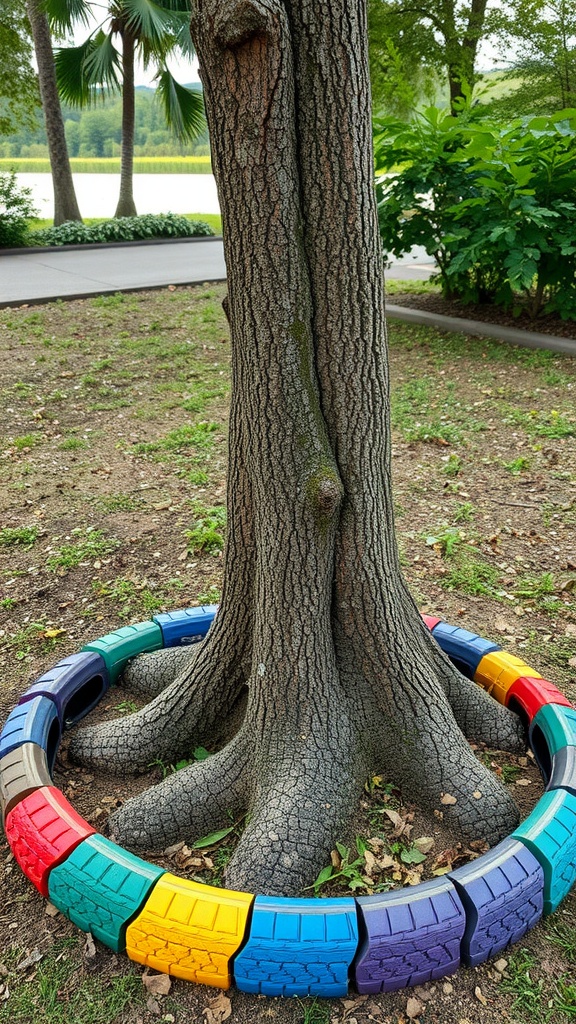
Recycled tires can bring a splash of color and creativity to any garden or park. In this image, you can see a tree beautifully bordered with a variety of colorful tire sections. This not only adds an artistic touch but also serves a practical purpose.
The vibrant colors create a cheerful atmosphere, making the area more inviting. They draw attention to the tree, showcasing it as a focal point in the landscape. Plus, using tires is an eco-friendly way to repurpose materials that would otherwise end up in landfills.
This type of edging is especially useful for protecting tree roots. The tires create a barrier that can keep grass and weeds at bay while allowing water to soak into the soil. It’s a simple yet effective method to maintain a healthy environment for the tree.
In addition, this design can inspire others to think outside the box. Whether you have a small garden or a large park, using recycled materials like tires can enhance the beauty of your space while being environmentally responsible.
Vertical Garden Walls as Tree Edges
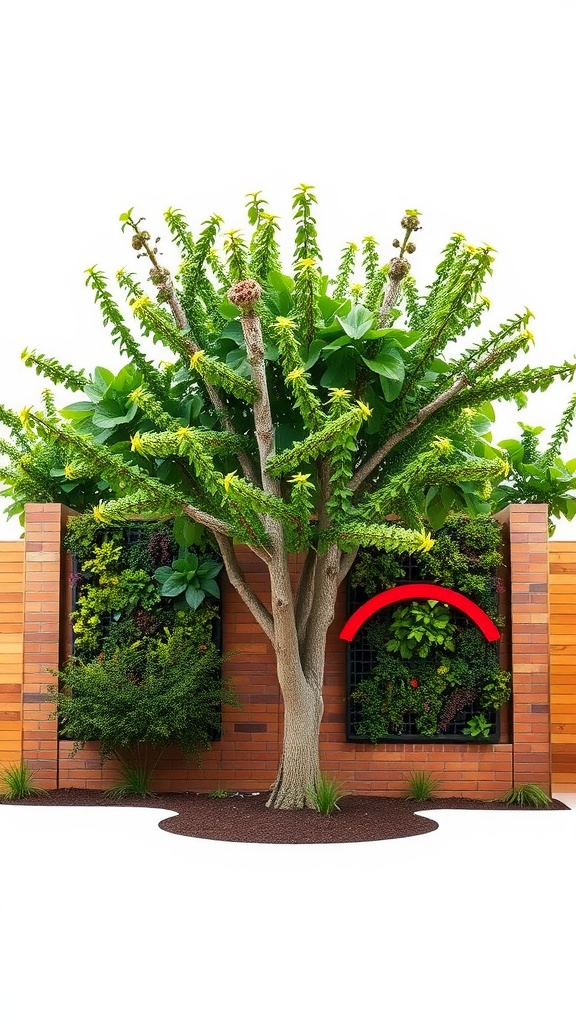
Vertical gardens can add a unique touch to any outdoor space, especially when used alongside trees. In the image, you can see a lovely tree surrounded by a vibrant vertical garden wall. This combination creates a natural, lush environment that can transform an ordinary backyard into a refreshing oasis.
The tree stands proudly at the center, showcasing its beautiful foliage. The green wall on either side complements the tree beautifully, offering a rich tapestry of plants that enhance the overall aesthetic. This kind of setup not only looks appealing but also provides additional benefits like improved air quality.
Using vertical gardens around trees can also help maximize space. If you have limited ground area, this method lets you grow more plants without taking up too much room. Plus, the variety of colors and textures can bring energy to your garden.
When planning your vertical garden, consider using plants that thrive in your local climate. This will ensure they flourish and enhance the beauty of your tree. Overall, the combination of vertical gardens and trees creates a harmonious and inviting atmosphere in any outdoor area.
Eroded Stone Edging for a Rustic Feel
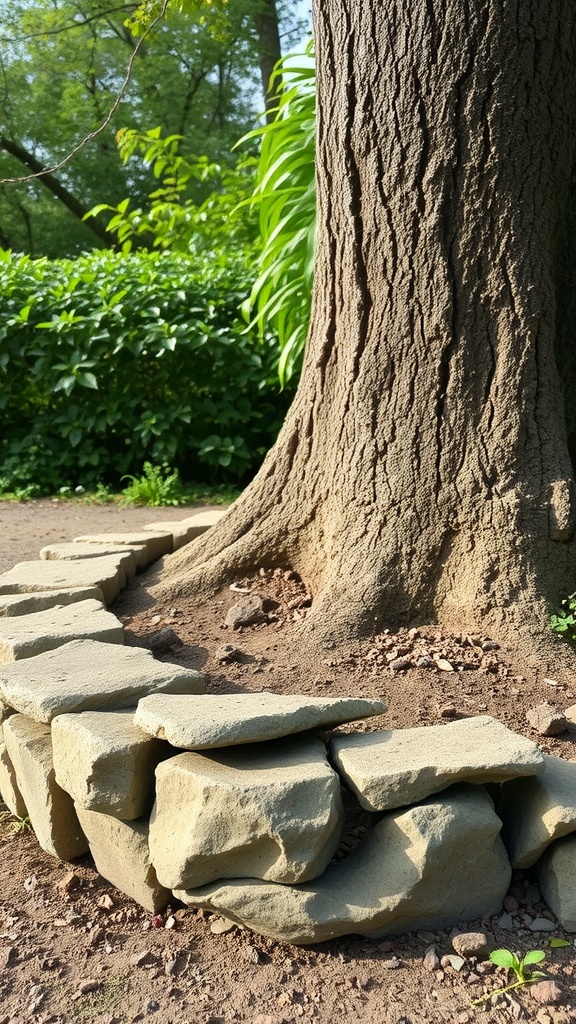
When you think about landscaping around trees, eroded stone edging can really add a unique touch. This kind of stone provides a rustic charm that makes your garden feel more natural. The uneven shapes of the stones mimic the organic forms of nature, enhancing the beauty of the area.
In the image, you can see how the stone edging curves gently around the base of the tree. This not only outlines the tree beautifully but also protects its roots. It creates a defined space that separates the garden bed from the rest of the yard. The earthy tones of the stones complement the tree bark and surrounding greenery perfectly.
Using stone edging is also practical. It helps reduce erosion and keeps soil in place, especially during heavy rains. Plus, it can provide a barrier against weeds, making maintenance easier. If you’re looking for a way to elevate your garden while keeping it low-maintenance, this could be a great option.
So, when planning your garden layout, consider how eroded stone edging can enhance your space. It’s a simple yet effective way to bring a touch of nature into your outdoor area.
Low-growing Shrubs for Edging
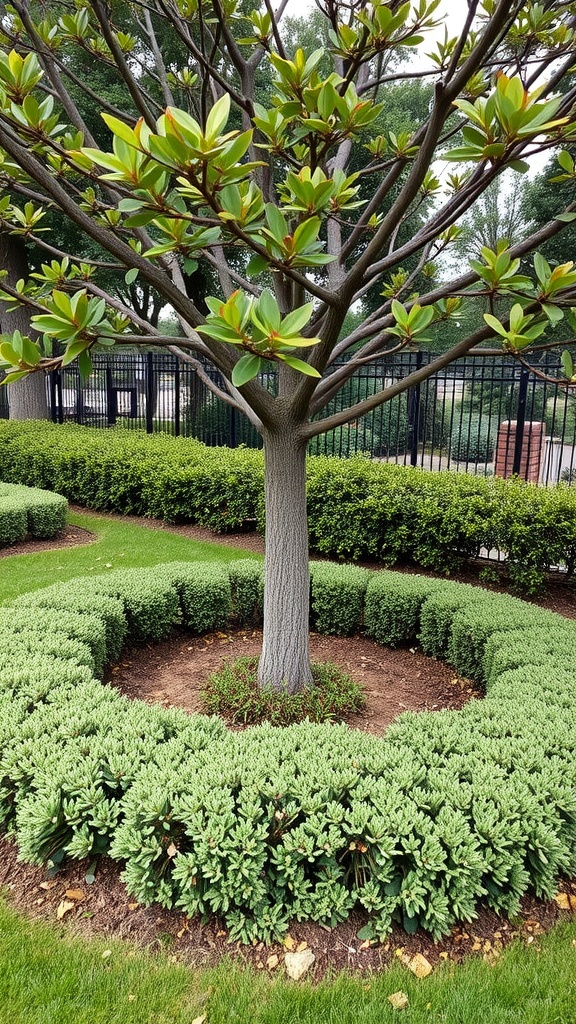
In the image, you can see a lovely tree surrounded by a ring of low-growing shrubs. This setup is a fantastic way to create a natural border around the tree, adding both beauty and structure to your landscape. The green shrubs form a neat circle, contrasting nicely with the tree’s trunk and vibrant leaves.
When choosing low-growing shrubs for edging, consider varieties that complement your tree and the surrounding area. Options like boxwood or dwarf yaupon holly work well. They not only look great but also provide a tidy appearance that frames the tree beautifully.
These shrubs are relatively easy to care for and can thrive in various soil types. Regular trimming keeps them in shape and encourages healthy growth. This maintenance helps them maintain their form, creating a sharp, clean line around your tree.
In addition to their aesthetic benefits, low-growing shrubs can help retain moisture in the soil and suppress weeds. This makes your garden easier to maintain while keeping it looking fresh. So, if you’re looking for a simple way to enhance your garden, consider adding low-growing shrubs as an edging around your trees!
Seasonal Edging Themes for Year-round Appeal
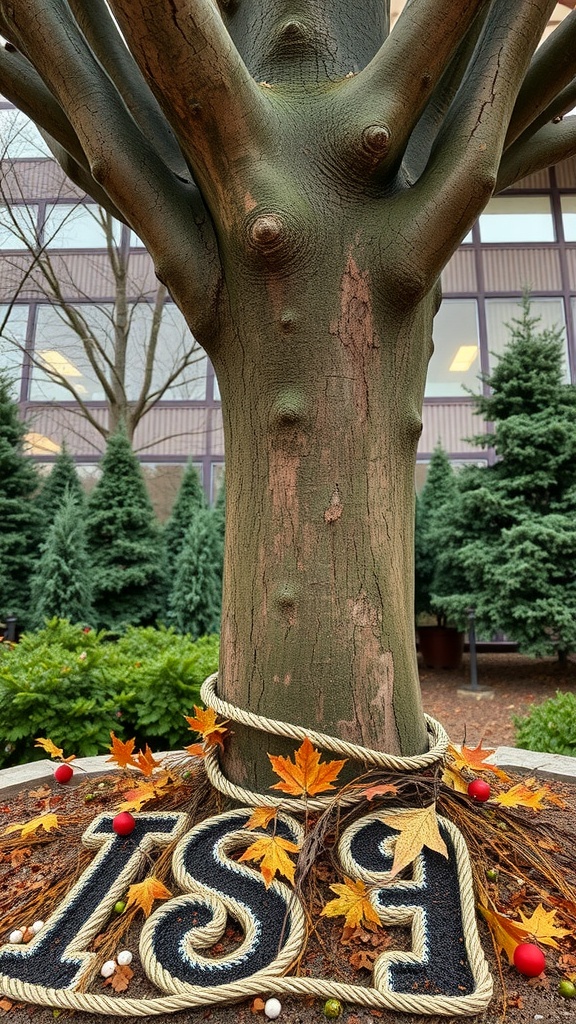
When it comes to edging around trees, seasonal themes can breathe life into your outdoor space. The image here captures a unique edging approach with natural elements, blending them beautifully around the tree base. The earthy tones of the tree trunk contrast nicely with vibrant fall leaves, creating a warm and inviting atmosphere.
Incorporating seasonal decorations, like these colorful leaves and simple ornaments, can enhance the aesthetic appeal. You can switch it up based on the time of year—think bright flowers in spring, lush greenery in summer, and cozy, rustic elements in fall and winter. It’s a fun way to keep your garden fresh and engaging.
This particular setup features a rope design that artistically wraps around the tree, adding texture and a natural feel. It highlights how simple materials can transform an ordinary space into something eye-catching and charming. Little touches like this can make a big difference, inviting people to appreciate the beauty of nature right in their own backyard.
Mixed Material Edging for Visual Interest
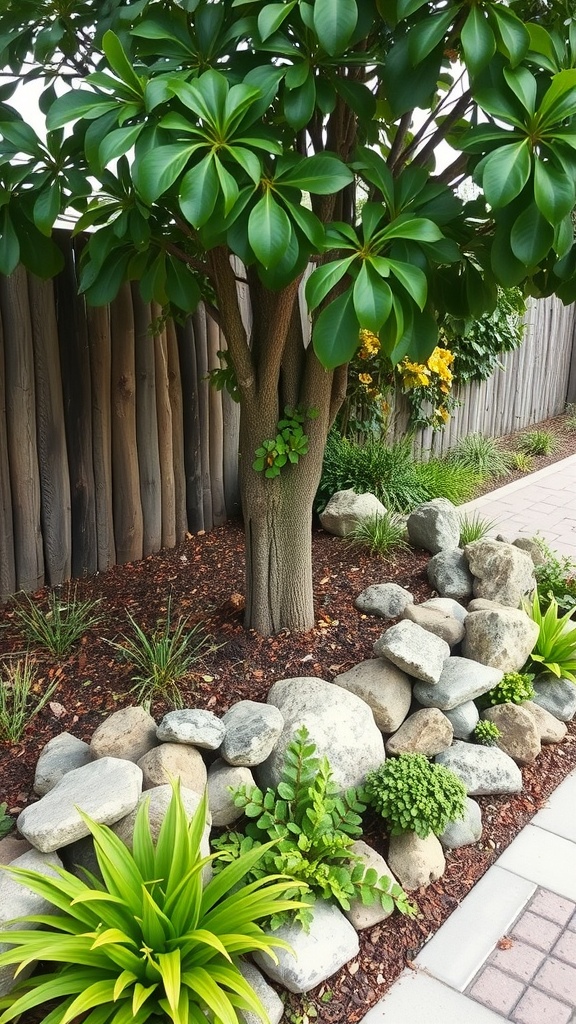
When it comes to landscaping around trees, mixing materials can really enhance the visual appeal. In the image, we see a well-defined area around the tree, showcasing a blend of rocks and lush greenery.
The use of various sized stones creates a natural look that complements the tree’s trunk. This technique not only highlights the tree but also offers a transition from the garden to the walkway. The earthy tones of the rocks blend nicely with the vibrant green leaves above.
Adding plants like ferns or ornamental grasses around the base adds depth and texture. These plants create a soft border, contrasting with the hard edges of the stones. It’s a simple way to make the area feel more alive and inviting.
Remember, using these mixed materials doesn’t just look good; it can also help with soil health and moisture retention around the tree. So, whether you’re creating a cozy nook, or just defining the area, a mix of stones and plants can create a welcoming vibe around your trees.
Stenciled Concrete Edges for Artistic Expression
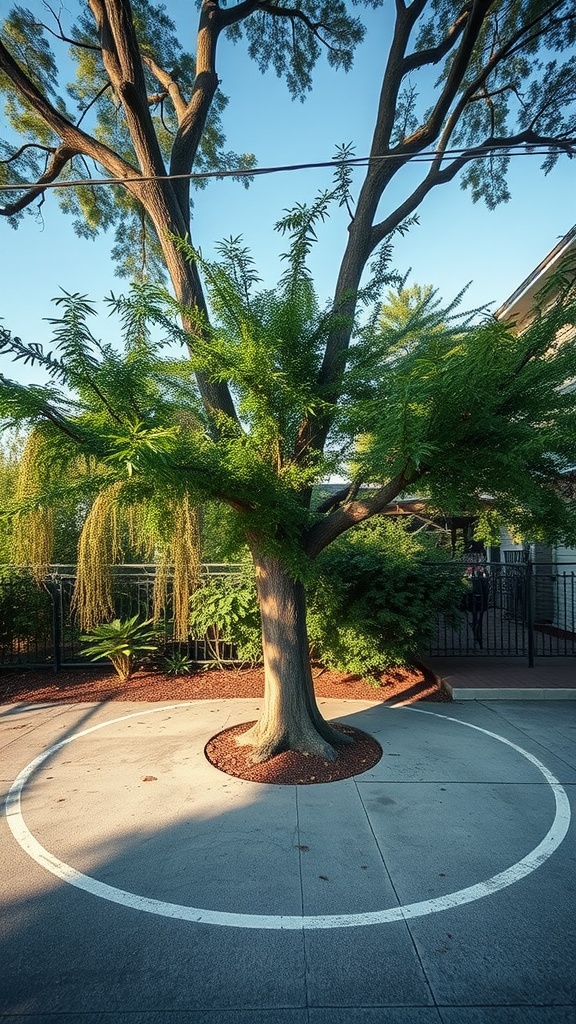
Edging around trees can create a unique visual appeal in a landscape. In this image, we see a tree beautifully framed by a circular concrete edge. The white stencil not only defines the space but also adds a touch of creativity to the area.
The contrast between the natural elements and the geometric shape draws attention to the tree, highlighting its beauty. This technique can be a fun way to enhance your garden or yard. It invites onlookers to appreciate both the tree and the surrounding space.
Using stenciled concrete edges is straightforward. A simple mix of concrete can be poured into a circular mold around the base of the tree, creating that crisp outline. You can even personalize it with colors or designs that reflect your style. This approach adds artistic expression and can make any outdoor setting feel more curated.
Innovative Water Features Near Tree Edging
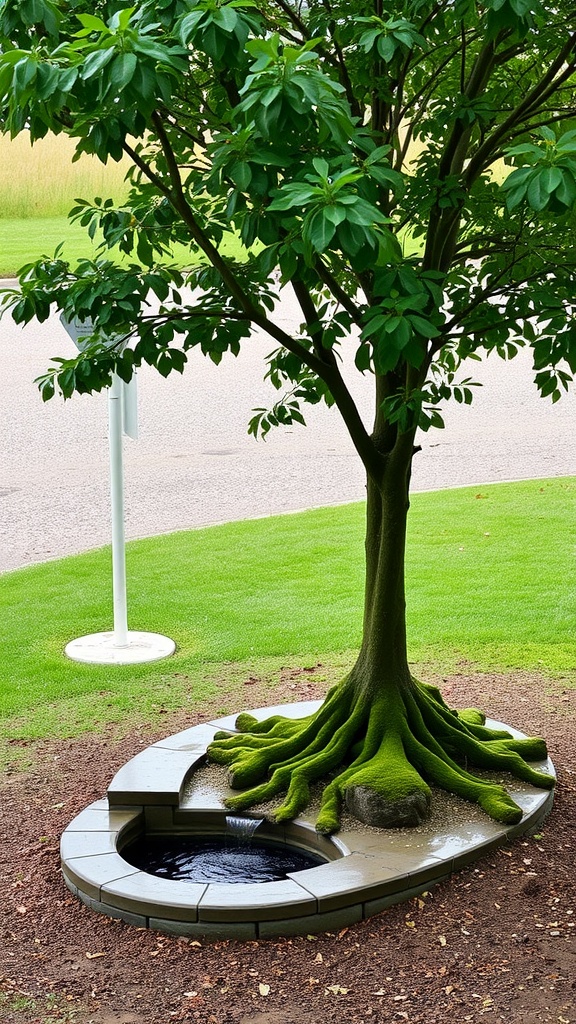
When thinking about landscaping, adding water features around trees can really enhance the natural beauty of your outdoor space. In the image, you can see a lovely tree with vibrant green leaves and a unique water feature right at its base.
The design cleverly integrates the tree with a circular stone edge that cradles a small pool of water. This not only brings a soothing sound of flowing water but also creates a serene atmosphere. The moss-covered roots add a touch of nature and help blend the feature seamlessly into the landscape.
Water features like this can be both functional and decorative. They provide a refreshing spot for birds and other wildlife, creating a lively scene. Plus, the gentle movement of water can be calming, making your garden an inviting place to relax.
Whether you want to create a tranquil retreat or a focal point in your yard, consider how water features can work with existing trees. Choosing the right size and shape can make all the difference in achieving a balanced look. So, why not think about placing a small pond or a fountain near your favorite trees? It could become the highlight of your garden!
Garden Furniture Integration with Tree Edging
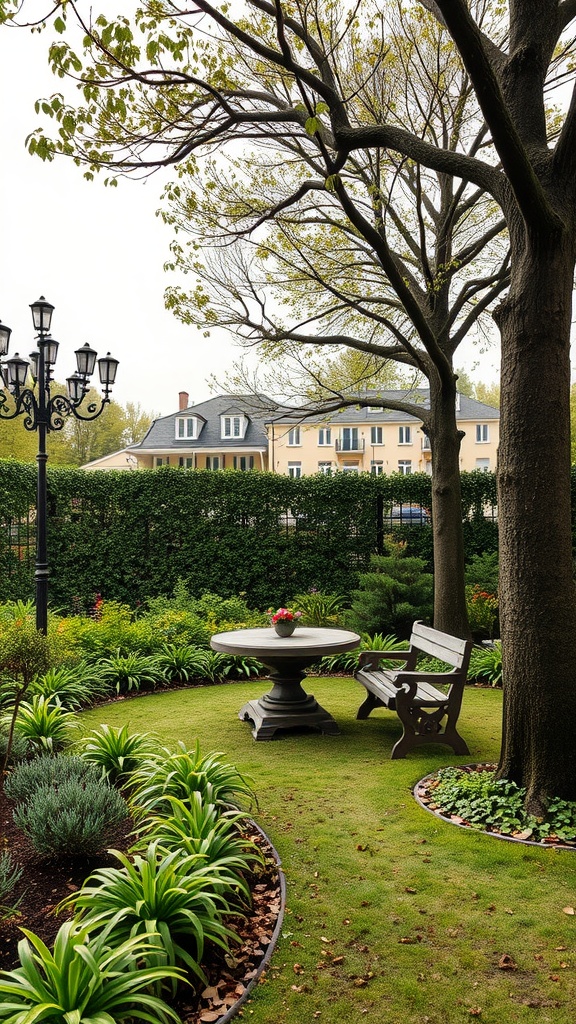
Creating a cozy garden space around trees can be both functional and visually appealing. In the image, you see a lovely setup that showcases how to integrate furniture with the natural beauty of trees. The round table and bench invite relaxation, making it a perfect spot for a casual chat or a quiet read.
The tree edging plays a crucial role here. It frames the area beautifully, separating the garden furniture from the surrounding greenery. This not only enhances the aesthetic but also defines the space, making it feel more intentional. Using natural materials for the edging can blend seamlessly with the landscape.
Consider adding some potted plants to the table or nearby to bring in color and life. The gentle curves of the edging complement the round table and make the whole setup feel harmonious. Plus, it allows for easy maintenance and a tidy appearance.
When planning your own garden furniture layout, think about how the trees can provide shade and ambiance. A spot like this invites you to spend hours outdoors, enjoying the fresh air. So, grab a good book or a cup of coffee, and let the trees work their magic in your garden.
Crisp Stone Edging for Tree Bases
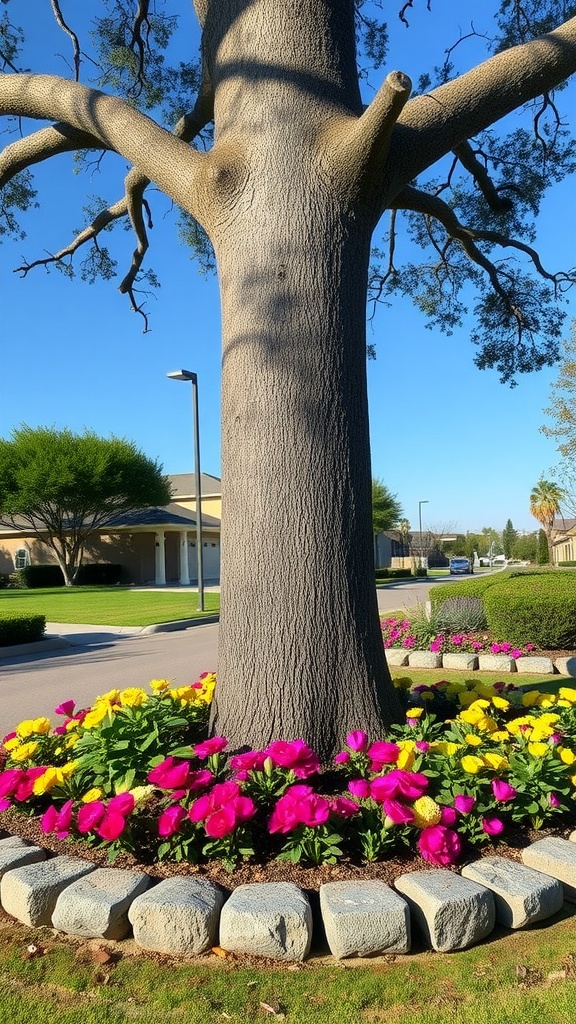
When it comes to landscaping, creating a neat and inviting look around trees can make a big difference. The image here showcases a tree base beautifully surrounded by vibrant flowers and crisp stone edging. This combination not only enhances the visual appeal but also helps in maintaining a clean garden space.
The stone edging acts as a barrier, keeping the flowers contained while providing a structured appearance. It defines the space around the tree, making it clear where the garden bed begins and ends. Plus, the stones can help prevent grass and weeds from encroaching on the flower bed, making maintenance easier.
The vibrant flowers, in shades of pink and yellow, add a splash of color that catches the eye. They not only attract pollinators but also bring life to the area. Choosing flowers that bloom at different times can ensure that there’s always something in bloom throughout the seasons.
Another bonus of using stone edging is durability. Unlike wood, which can rot or warp, stone lasts for years and can handle various weather conditions. It’s a practical choice that still looks good! If you’re thinking about your own tree bases, consider how a simple stone edge can transform the space.
Natural Wood Border for Rustic Appeal
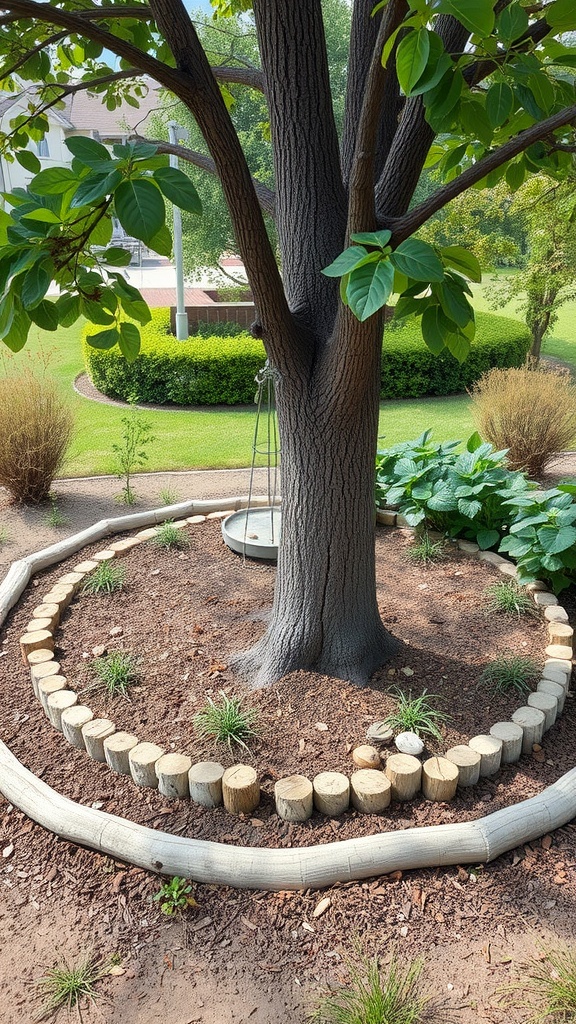
Creating a natural wood border around trees adds a charming touch to any landscape. In the image, you can see a tree standing proudly with a circular wooden edge that beautifully frames its base.
This wood border serves not only as decoration but also helps define the area around the tree. It adds a rustic vibe that connects the garden with nature. The earthy tones of the wood complement the tree’s bark, creating a harmonious look.
The circular design is inviting and encourages interaction with the space. It can also help keep mulch in place, which is beneficial for tree health. Plus, the little grass patches poking through add a playful touch, enhancing the overall appeal.
Consider using similar techniques in your own garden. Whether you choose logs, planks, or other natural materials, a wood border can elevate your landscaping and invite more appreciation for the trees you cherish.
